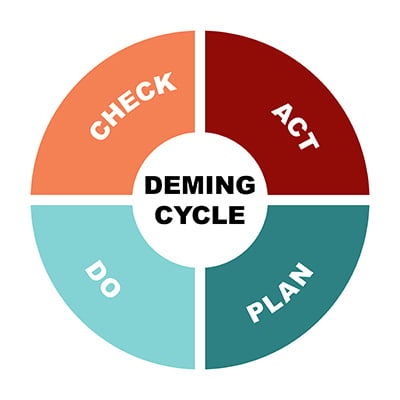I first worked in an agile team as part of an engineering management team that led a successful agile transition. I wanted to learn more about what agile was, so read widely about lean and agile. I found that the books I read all referred to W. Edwards Deming and often referred to the Deming Cycle.
When I studied the Deming Cycle it was very familiar to me, and I found that there was a good reason for this. Scrum uses the Deming Cycle and I was a member of a Scrum team. One of the books I read was by Jeff Sutherland, one of the two co-creators of Scrum, and he said that the Deming Cycle was ‘how scrum product development was done’.
The Deming Cycle helps teams to learn and improve across an array of industries.
There are four parts to the Deming cycle:
- Plan – Plan a change or test, aimed at improvement
- Do – Build and test
- Study – What was wrong? And what was right?
- Act – Change the way of working based on real results.
If the results of the change or test are not satisfactory, the team may decide to follow a different course of action. It is acceptable if the ‘act’ is to discard the change. This enables a development team to change direction after an iteration.
The cycle is repeated and the team moves forward with new knowledge of their product.
Deming said ‘the reason to study the result of a change is to learn how to improve tomorrow's product,’ and wrote that everyone in the team can take part. The aim of a team is to improve the input and output of each stage. Everyone on the team has a chance to contribute ideas.
The Deming Cycle
The Deming Cycle is a circle divided into four quarters. All four parts of the cycle are related to one another and there is no hierarchy.
Deming learnt the cycle when he worked for Walter Shewhart at Bell Telephone Labs in 1920. He called it the Shewhart Cycle, but it went into use as the Deming Cycle.

In Japan, the Deming Cycle is sometimes known as the Deming Wheel. Deming gave a lecture in Japan in which he spoke about the cycle as a wheel that rolls along the line of ‘concepts regarding product quality’ and the ‘sense of responsibility for product quality’. The cycle has no beginning and no end, it just keeps on rolling.
Deming wrote that the ‘cycle is a flow diagram for learning and for improvement of a process or of a product’.
The cycle is a driving force for innovation and that has two aspects. The first aspect is a consumer cycle that helps us understand what we must improve. The second aspect is the cycle of learning. This second aspect helps us to achieve improvement.
The consumer cycle is used for planning and improvement. This describes when development teams plan the next feature that they are going to work on and their planning takes into account learning from previous iterations. Toyota used learning from previous iterations when they launched the Corolla in the USA. Development teams can use the cycle in this way to find solutions to customers problems.
The second aspect of the cycle can be used by engineers to achieve product improvement. This aspect is used by development teams to develop solutions for customers.
If planning is rushed, the cycle of learning is also rushed and it is also useful to ask questions about the proposed work. It was suggested that it is useful to have a statistician ask questions about the work being planned, such as what is the purpose of this work? Development teams do not have statisticians but do have testers who often perform this role.
After a cycle of work is completed, the team should study the results. There are three possible actions, accepting the change, rejecting the change, or that there is insufficient data to draw a conclusion. If there is not enough data to come to a conclusion, part or all of the work may have to be redesigned.
In Japan, the cycle became known as the ‘plan-do-check-act’ cycle (PDCA), however Deming preferred to call it the ‘plan-do-study-act’ cycle (PDSA). The cycle is about learning and he felt that ‘check’ meant to inspect or hold up, whereas ‘study’ is part of the learning process. He said that ‘the Deming circle is a quality control programme. It is a plan for management’ and that the QC circle is ‘for a group of people that work on faults encountered at the local level’.
For you
Be part of something bigger, join BCS, The Chartered Institute for IT.
Deming worked in Japan after World War Two to help rebuild Japan's economy, and his ideas influenced Japan's economic development . Jeffrey Liker said that the Deming Cycle embodies the learning cycle in the Toyota Production System. The word ‘lean’ comes from a study done by MIT and is an American description of Japanese production systems. Of primary interest in the study was the Toyota Production System. That the Deming Cycle influenced the Toyota Production System shows that the Deming Cycle influenced lean ideas.
The Deming Cycle has also influenced agile. Jeff Sutherland wrote that ‘the retrospective is the ‘check’ of Demings’ plan-do-check-act cycle. The key is getting to the ‘act’ part'. When I am facilitating a retrospective, I find it useful to bear in mind that the retrospective was designed to be part of the Deming Cycle. This means that a retrospective should be covering one iteration of the team's work.
Other cycles we use in our work can also be seen to have been influenced by the Deming Cycle or come from the same space. There are articles stating that Eric Ries’ ‘build-measure-learn’ cycle has been influenced by the Deming Cycle. Pascal Dennis argues that ‘design thinking’ and ‘plan-do-study-act’ are rooted in the same tradition. The Deming Institute website has an article about ‘jobs to be done’ that says it’s ‘a great example of extending Deming’s ideas’. John Willis, one of the authors of The DevOps Handbook, wrote ’almost everything Dr. Deming was saying was the foundation for lean software, agile, and DevOps’. Understanding the Deming Cycle helps us understand these cycles, practices and theories.
Conclusion
There are many reasons for us to learn about the Deming Cycle. It helps teams learn and improve, which is why the quote from W. Edwards Deming that ‘ We are here to learn, make a difference and have fun’ sums up the Deming Cycle. Another powerful reason for us, as IT professionals, to understand the Deming Cycle is because we often work in lean or agile teams, which are influenced by the Deming Cycle. Engineering teams have been using the cycle to improve the quality of their work for nearly one hundred years, so it is reasonable to expect the Deming Cycle to be used for the foreseeable future.
About the author
Mike Harris is the solo tester at Geckoboard and the Programme Secretary for the BCS Specialist Interest Group in Software Testing. He has a blog: https://testandanalysis.home.blog/ and is a co-author of ‘How Can I Test This?‘
Follow Mike on Twitter: @TestAndAnalysis and LinkedIn
Further resources:
- The PDSA Cycle
- eLearning from the Deming Institute: DemingNext contains a course on the PDSA

















